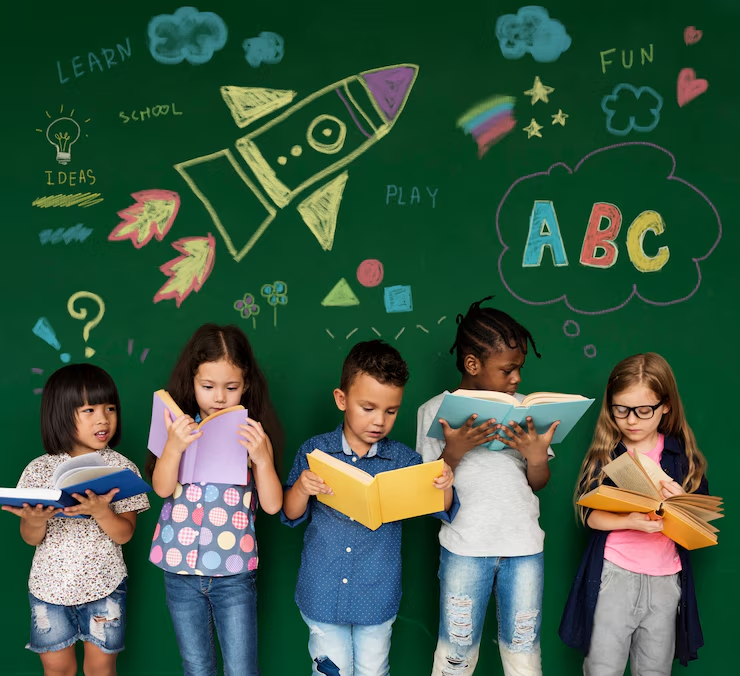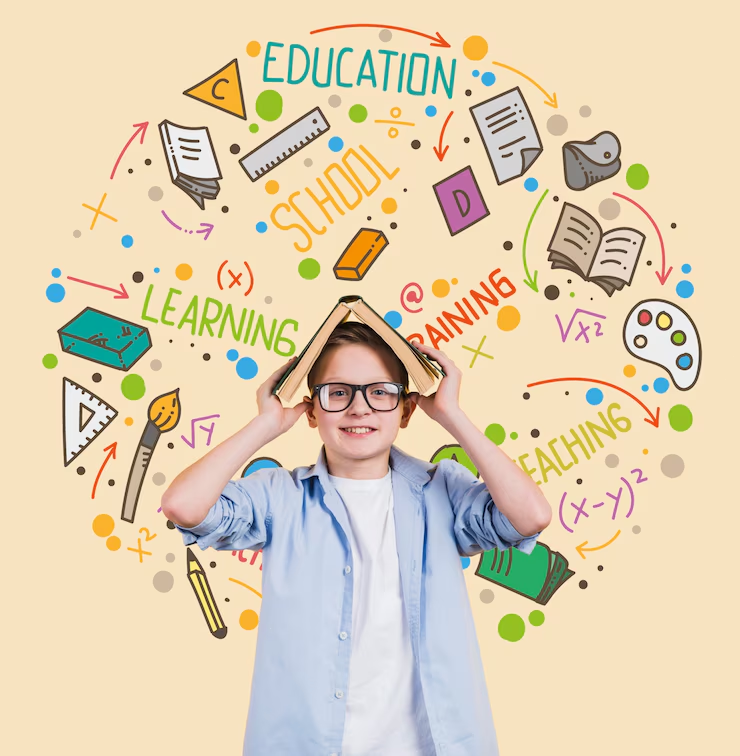Education for kids is not just about filling young minds with knowledge; it’s about fostering curiosity, creativity, and critical thinking. In today’s rapidly evolving world, traditional teaching methods alone may not suffice. Innovative strategies are essential to engage children effectively and enhance their learning journey. This post explores seven powerful strategies that can revolutionise education for kids, ensuring they not only excel academically but also develop a love for learning.
Table of Contents
1. Embrace Technology: Digital Tools for Modern Learning
Incorporating technology into education for kids can make learning more interactive and engaging. Here’s how technology can enhance the educational experience:
- Educational Apps and Games: Tools like Khan Academy Kids, ABCmouse, and Duolingo make learning fun and interactive.
- Interactive Whiteboards: These allow teachers to present lessons in dynamic ways, incorporating multimedia elements.
- Virtual Reality (VR) and Augmented Reality (AR): VR and AR can create immersive learning experiences, such as virtual field trips or interactive science simulations.
External Link: For more on educational apps, visit Common Sense Media.
2. Personalized Learning: Tailoring Education to Individual Needs

Every child learns differently, and personalized learning can address this by adapting educational content to fit each student’s unique needs. Key components include:
- Adaptive Learning Platforms: Platforms like DreamBox and IXL adjust the difficulty of exercises based on the child’s performance.
- Individual Learning Plans: Customized plans that focus on a child’s strengths and areas needing improvement.
- Flexible Learning Environments: Providing choices in how students learn, whether through projects, reading, or hands-on activities.
External Link: Learn more about personalized learning at Edutopia.
3. Hands-On Learning: Engaging Activities for Better Understanding
Hands-on learning is a powerful approach that involves active participation and practical experiences. Here’s how it can benefit education for kids:
- Science Experiments: Simple experiments can make complex concepts more understandable.
- Art Projects: Creative activities enhance critical thinking and problem-solving skills.
- Field Trips: Visiting museums, parks, or factories provides real-world context to theoretical knowledge.
External Link: Discover more about hands-on learning at Education.com.
4. Collaborative Learning: Fostering Teamwork and Communication
Collaboration is an essential skill in today’s world. Collaborative learning strategies include:
- Group Projects: Working together on assignments encourages teamwork and communication.
- Peer Teaching: Allowing students to teach each other reinforces their own understanding.
- Discussion-Based Classes: Promotes critical thinking and helps students articulate their thoughts.
External Link: For insights on collaborative learning, check out The Teacher’s Lounge.
5. Mindfulness and Emotional Learning: Building Resilience and Focus
Incorporating mindfulness and emotional learning into education for kids can improve their overall well-being and academic performance. Key strategies include:
- Mindfulness Exercises: Activities like deep breathing and meditation can reduce stress and improve focus.
- Social-Emotional Learning (SEL): Programs such as CASEL help children understand and manage their emotions.
- Positive Reinforcement: Encouraging and rewarding positive behaviors and achievements.
External Link: Explore mindfulness and emotional learning resources at CASEL.
6. STEM Education: Preparing Kids for Future Careers
STEM (Science, Technology, Engineering, and Mathematics) education is crucial for preparing kids for future careers. Effective STEM education strategies include:
- Hands-On STEM Kits: Kits like LEGO Mindstorms or littleBits encourage exploration and innovation.
- Coding Programs: Platforms such as Code.org and Scratch introduce children to programming in a fun way.
- STEM Clubs: After-school programs and clubs that focus on various STEM fields.
External Link: Learn more about STEM education at STEM.org.
7. Encourage Reading: Cultivating a Lifelong Love for Books

Reading is fundamental to education for kids and offers numerous benefits. To promote reading:
- Diverse Reading Materials: Provide books across various genres and topics to spark interest.
- Reading Aloud: Reading together enhances comprehension and vocabulary.
- Book Clubs: Join or create book clubs to discuss and explore different books with peers.
External Link: For reading resources, visit Reading Rockets.
Conclusion
Innovative strategies in education for kids can transform their learning experiences, making them more engaging and effective. By embracing technology, personalizing learning, and incorporating hands-on and collaborative methods, we can create an educational environment that not only supports academic success but also fosters a lifelong love of learning. The integration of mindfulness, STEM education, and reading further enhances this experience, preparing children for a bright future.
Implementing these strategies requires a proactive approach from educators and parents alike. By staying informed and adapting to new educational trends, we can ensure that our children receive the best possible start in their academic journey.
External Link: For more insights on innovative educational strategies, visit EdTech Magazine.
Comprehensive FAQ on Education for Kids*
1. What Is Education for Kids?
Education for kids refers to the various methods, practices, and tools used to facilitate learning and development in children. It encompasses formal schooling, informal learning experiences, and home-based education. This broad field includes:
- Academic Subjects: Math, science, language arts, and social studies.
- Life Skills: Critical thinking, problem-solving, and social skills.
- Extracurricular Activities: Sports, arts, and hobbies that contribute to well-rounded development.
For More Information Click Here
2. Why Is Early Education Important for Kids?

Early education is crucial for several reasons:
- Brain Development: Early experiences shape brain development and cognitive skills.
- Foundation for Future Learning: Early learning sets the stage for academic success and lifelong learning.
- Social Skills: Young children learn to interact with peers, follow instructions, and develop communication skills.
- Emotional Growth: Early education helps children understand and manage their emotions.
External Link: For more information on the importance of early education, visit Zero to Three.
3. What Are the Different Types of Education for Kids?
Education for kids comes in various forms, including:
- Formal Education: Structured schooling provided by educational institutions such as preschools, elementary schools, and high schools.
- Informal Education: Learning that occurs outside formal settings, such as through family interactions, community programs, and self-directed activities.
- Home Education (Homeschooling): A personalized approach where parents or tutors provide education in a home setting.
- Online Education: Digital platforms and resources that offer learning opportunities through the internet.
External Link: Explore the types of education further at Education.com.
4. How Can Technology Enhance Education for Kids?
Technology can significantly enhance education for kids in several ways:
- Interactive Learning: Educational apps and games make learning more engaging and interactive.
- Access to Resources: Online resources and digital libraries provide a wealth of information and learning materials.
- Personalized Learning: Adaptive learning platforms tailor educational content to individual needs.
- Global Connections: Technology enables communication and collaboration with peers and experts worldwide.
External Link: For insights on educational technology, visit Edutopia.
5. What Are Effective Strategies for Teaching Kids?
Effective teaching strategies for education for kids include:
- Active Learning: Involves hands-on activities and interactive experiences that engage students.
- Differentiated Instruction: Adapting teaching methods to accommodate different learning styles and abilities.
- Positive Reinforcement: Encouraging and rewarding positive behavior and achievements.
- Collaborative Learning: Promoting teamwork and group activities to enhance social and communication skills.
External Link: Discover more strategies at Teaching Strategies.
6. How Can Parents Support Their Child’s Education?
Parents play a crucial role in education for kids. Here’s how they can support their child’s learning:
- Create a Learning Environment: Set up a dedicated, distraction-free space for studying.
- Encourage Reading: Foster a love for reading by providing diverse books and reading together.
- Support Homework: Help with homework without doing it for them, and establish a regular study routine.
- Communicate with Teachers: Stay informed about your child’s progress and collaborate with educators.
External Link: Learn more about parental involvement at GreatSchools.
7. What Are the Benefits of Extracurricular Activities for Kids?
Extracurricular activities offer several benefits:
- Skill Development: Activities such as sports, music, and arts help develop various skills and talents.
- Socialization: Provides opportunities for kids to interact with peers and build friendships.
- Stress Relief: Engaging in hobbies and interests can reduce stress and improve overall well-being.
- Creativity and Problem-Solving: Encourages creative thinking and problem-solving skills.
External Link: Explore the benefits of extracurricular activities at Youth.gov.
8. How Does Social-Emotional Learning (SEL) Benefit Kids?
Social-Emotional Learning (SEL) benefits education for kids by:
- Improving Emotional Regulation: Helps children manage their emotions and develop empathy.
- Enhancing Relationships: Teaches skills for effective communication and relationship-building.
- Boosting Academic Performance: Students with strong SEL skills tend to perform better academically.
- Reducing Behavioral Issues: SEL can decrease instances of bullying and disciplinary problems.
External Link: For more on SEL, visit CASEL.
9. What Role Does Play Have in Education for Kids?
Play is a fundamental aspect of education for kids. It contributes to:
- Cognitive Development: Through imaginative and exploratory play, children learn problem-solving and critical thinking skills.
- Physical Development: Active play supports motor skills and overall physical health.
- Social Skills: Play encourages interaction with peers, teaching cooperation and negotiation.
- Emotional Growth: Play allows children to express their feelings and cope with stress.
External Link: Learn about the importance of play at National Association for the Education of Young Children (NAEYC).
10. What Are the Challenges in Modern Education for Kids?
Some challenges in education for kids today include:
- Screen Time: Excessive use of digital devices can impact physical health and social skills.
- Educational Inequality: Disparities in access to resources and quality education affect student outcomes.
- Standardized Testing: Overemphasis on testing can lead to stress and narrow the focus of education.
- Mental Health Issues: Increasing rates of anxiety and depression among students require attention and support.
External Link: For insights into educational challenges, visit Education Week.
11. How Can Schools Address Educational Inequality?
Schools can address educational inequality through:
- Equitable Resource Allocation: Ensuring that all students have access to necessary materials and opportunities.
- Support Programs: Implementing programs that provide additional help for disadvantaged students.
- Inclusive Curriculum: Developing curricula that reflect diverse perspectives and backgrounds.
- Community Engagement: Partnering with community organizations to support students and families.
External Link: Learn more about addressing educational inequality at American Educational Research Association (AERA).
12. What Are the Benefits of Multilingual Education for Kids?

Multilingual education offers several advantages:
– Cognitive Benefits:
Learning multiple languages enhances cognitive abilities and problem-solving skills.






